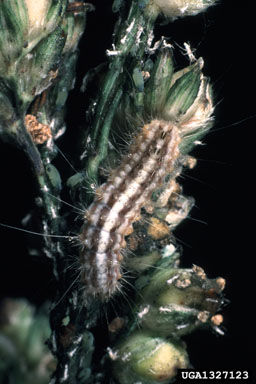Identification and Management of Grain Sorghum Headworms
August 3, 2023
Headworms are made up of three caterpillar species, corn earworm, fall armyworm and sorghum webworm.
CORN EARWORM
Corn earworms from their name prefer corn; however, they can infest grain sorghum. The larval head is light brown with bodies that vary from green, pink, yellowish, and near black with light and dark stripes lengthwise on the body. The dark stripe is divided by a narrow white line. The larvae can reach lengths of about two inches at maturity.1
FALL ARMYWORM
Fall armyworms are initially green out of the pupa but turn grayish brown as they mature. The larva has a distinctive inverted “Y” on the front of the head and lengthwise dark lines on its upper body. At maturity it may reach 1.5 inches long.1

SORGHUM WEBWORM
Sorghum webworms are smaller than corn earworms and fall armyworms. The body is flattened, yellow greenish, and has four lengthwise dark stripes. At maturity, the larvae are covered with hair, which can be irritating to some people when picked up. Webworms suspend themselves by spinning a thin silken thread when disturbed.1

Lifecycle and Potential Loss
Headworm moths lay several hundred eggs on sorghum grain heads before, during, and after flowering. However, because of natural predators, parasites, pathogens, and cannibalism among the larvae the initial population can be reduced.1
Sorghum is most vulnerable to headworms from flowering to soft dough (Figure 4). The general rule is that headworms may cause 5% potential yield loss per worm per head when the worms are feeding directly on the grain, about two weeks.2

Scouting for Headworms
Headworm scouting should start immediately after most of the sorghum heads have finished flowering. Because newly hatched worms are hard to see and count, a common scouting method is to bend the sorghum head into a clean white bucket and shake the worms off for counting. Headworm threshold levels may vary with the size of the worm, insecticide cost, and crop value; however, atypical threshold is one to two larvae per sorghum head. The threshold for webworms is higher than thresholds for corn earworms or fall armyworms because of their small size. If necessary, an insecticide application can be delayed until five or more larvae per head are present.1
Treatment
Common treatments include Blackhawk® Naturalyte® Insect Control (a.i. = spinosad) and Prevathon® Insect Control (a.i. = rynaxypyr). Relatively new, cost-effective products are now available for controlling headworms in sorghum. These are pest-specific viruses, formulated as biological pesticides, that can be applied the same as any foliar insecticide. Sold under the brand names Heligen® Biological Insecticide (for corn earworm) or Fawligen® Biological Insecticide (for fall armyworm), these products are highly specific, claiming to eliminate only the target pest, and spare beneficial insects.3
Andrew Swanson
Agronomist
Sources
1Headworms. United Sorghum Checkoff Program https://www.sorghumcheckoff.com/our-farmers/insects-weeds-diseases/insect-control/headworms/.
2Whitworth, J. and Schwarting, H. 2015. Sorghum headworms. Kansas Insect Newsletter.Kansas State University. http://entomology.k-state.edu/doc/Newsletters/2015/KSInsectNewsletter19.pdf
3Michaud, J.P. 2022. Scout for headworms in sorghum from flowering into milk stage. K State Agronomy eUpdates. Kansas State University. https://blogs.k-state.edu/kansasbugs/2022/08/04/scout-for-headworms-in-sorghum-from-flowering-into-milk-stage/.
Web sources verified 6/22/23. 1110_274488